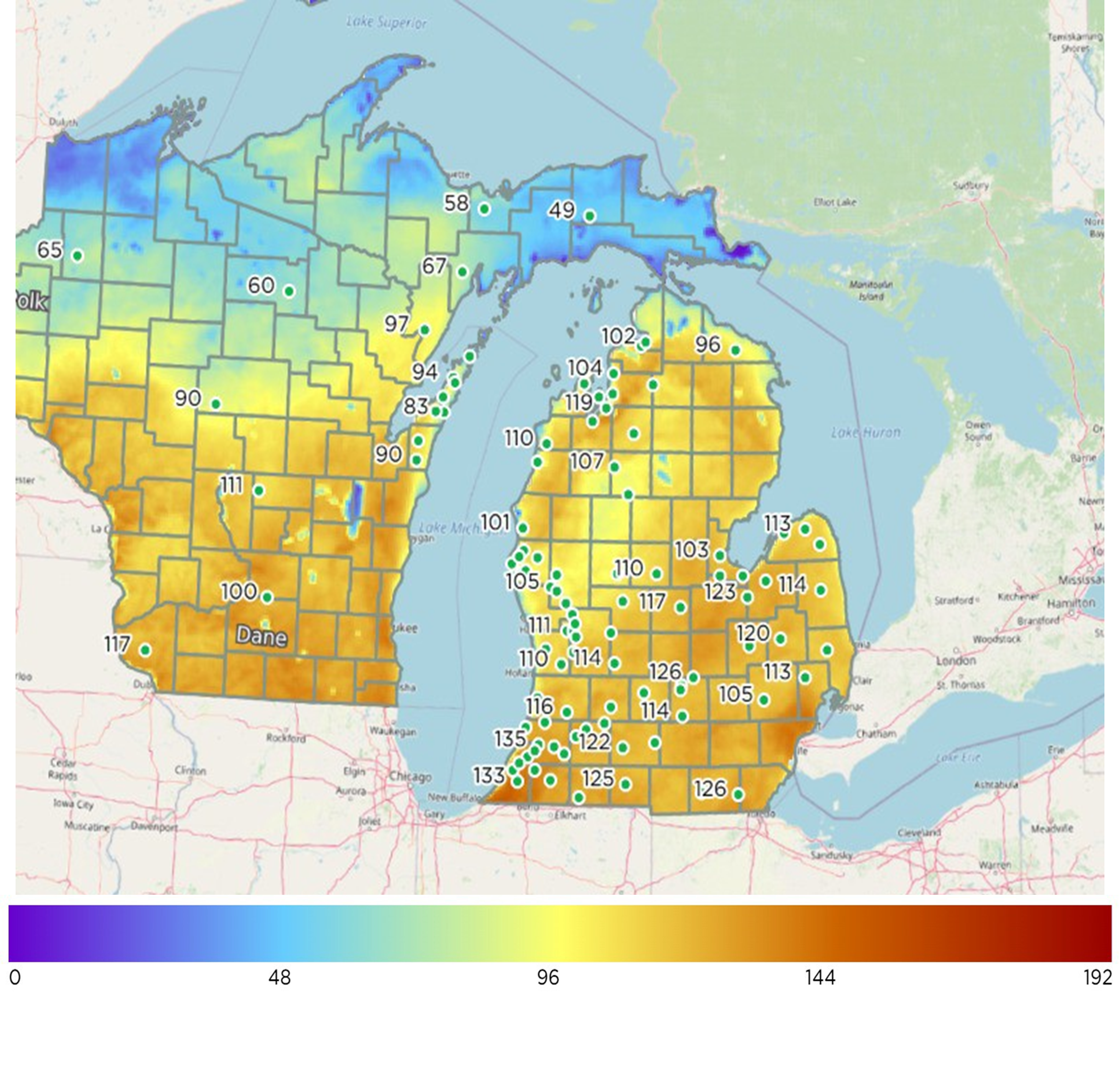Christmas tree spring update – April 19, 2023
Warmer than typical temperatures have pushed much of the state seven to 14 days ahead in degree day accumulation and will affect management on the farm.

Weather update
The spring weather rollercoaster is in full effect for Michigan. Extremes in temperature have been common over the week of April 17. In Grand Rapids, Michigan, highs went from near 80 degrees Fahrenheit down to 30 F with snow flurries within 48 hours. Since the week of April 10, we have gone from several days behind normal in growing degree day (GDD) accumulation to over two weeks ahead of normal (Photo 1). Michigan current GDD values range from 130 GDD50 in southern Michigan to 50 GDD50 in the Upper Peninsula (Photo 2).
Growing degree days can provide insight into plant and insect development. Current indications are that growers need to be prepared for early plant development and pest pressure. More information on Christmas tree GDD, pest modeling and weather can be found at Michigan State University Enviroweather’s Christmas Trees Management Tools page.

Insect update
Balsam twig aphid
A significant insect pest of fir trees is balsam twig aphid (BTA). This pest can be especially problematic for Fraser and Balsam fir, however any true fir species can be attacked. Check trees that are within a year of two of harvest for signs of damage (younger trees do not require control measures). Balsam twig aphid feed on needle sap causing damage of twisted needle growth (Photo 3). Balsam twig aphid also secretes a sugary substance called honey dew while feeding. Honeydew attracts stinging insects and acts as a growth medium for sooty mold.
The treatment threshold for balsam twig aphid is an average of two or more aphids per tree. Insecticide treatment should be applied between 100 to 150 GDD50. Treatments after this window will not control balsam twig aphid but can damage beneficial insect populations.

2023 pesticide updates
The herbicide topramezone, trade name Frequency, has recently been labeled for Christmas tree production. This product has a different mode of action (Group 27) than other Christmas tree herbicides, which can be useful in preventing herbicide resistant weeds. It has both pre- and post- emergent capabilities, and is labeled for broadleaf (such as horseweed, common chickweed, clover, smartweed and nightshade) and grass (such as barnyardgrass, large crabgrass and johnsongrass) control. Over the top application of this product should be avoided due to potential tree injury. Directed sprays are recommended.
The availability of herbicide oryzalin (Surflan) may be greatly reduced now and into the future. The manufacturer of this herbicide has stopped production after numerous manufacturing accidents at the production facility. The future availability of this herbicide is unknown; however, the label is still active and any inventory growers have can be used. Oryzalin is a pre-emergent herbicide that works on both broadleaf and grass weeds.
The insecticide chlorpyrifos (various trade names) is unavailable in the marketplace. Chlorpyrifos still has a valid label for non-edible crops (including Christmas trees), however due to market regulations, chemical suppliers cannot currently sell this product. As a result of these problems, it seems likely that this product will no longer be a viable option for pest control. Check the Michigan Christmas Tree Pest Management Guide from Michigan State University Extension for alternative options.
A new insecticide product called Grandevo (active ingredient Chromobacterium subtsugae strain PRAA4-1t and spent fermentation media) is now labeled for Christmas tree production. Grandevo is organically certified and is labeled for control of various insect pests, such as bagworm, spongy moth and pine tip moth. An advantage of this insecticide is its softer chemistry and it is less likely to damage beneficial insects.
Farm reports
Depending on farm location, growers are applying preemergent herbicides, planting trees or waiting for better weather. Nursery producers are busy with digging transplants and shipping orders. Fertilizer applications should be made two weeks prior to budbreak, which normally occurs in May (depending on location and tree species). Tree roots will become active prior to budbreak and will be able to absorb nutrient applications. MSU Extension’s Nitrogen Management guide is a reference on determining rates of nitrogen fertilizer based on age of tree and tree species.
For management information and upcoming events, sign up to receive MSU Extension’s Christmas tree production newsletter. For general information, visit MSU Extension's Christmas Trees website.



 Print
Print Email
Email
